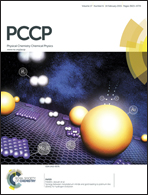A structure–activity relationship study of the toxicity of ionic liquids using an adapted Ferreira–Kiralj hydrophobicity parameter†
Abstract
The Ferreira–Kiralj hydrophobicity parameter Wc is a number fraction of hydrophobic carbon atoms and can be regarded as a constitutional descriptor since its calculation depends only on the number of polar and nonpolar carbons in a compound. Hydrophobicity is important to the toxicity of ionic liquids (ILs), which are salts by nature. Herein, a descriptor for this property was calculated using a simple adaptation of the type of polar carbon atoms included (WcAdap) to explore the possibility of its use in quantitative structure–activity relationship (QSAR) studies of ILs. The resulting model was tested using a database of ILs with toxicity against the Leukemia rat cell line IPC-81. Two other models were constructed using Crippen log P and Mannhold log P descriptors, which are both available in the free program PaDEL. The use of WcAdap led to a better and more indicative model. Thus, WcAdap may be a suitable molecular descriptor for the hydrophobicity of ILs in QSAR studies.


 Please wait while we load your content...
Please wait while we load your content...